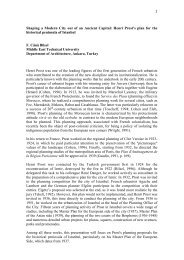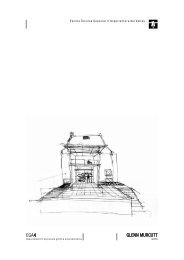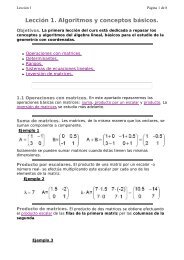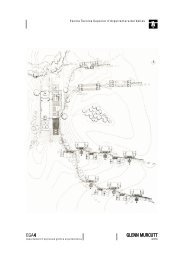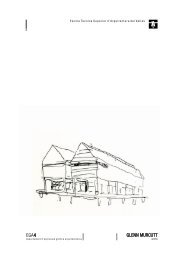You also want an ePaper? Increase the reach of your titles
YUMPU automatically turns print PDFs into web optimized ePapers that Google loves.
www.etsav.upc.es/urbpersp Andrea Peresthu<br />
In term of urban inequality, both old-kampong and<br />
squatter-kampong face the same fate. They are<br />
deliberately marginalized by the rapid encroachment of<br />
the spatial growth and the capitalism spirit. Throughout<br />
the aforementioned three stages of urban growth, old<br />
kampong is perhaps hardly considered in the blueprint<br />
of the regional economic and spatial planning.<br />
The same fate is shared by the informal migrant<br />
settlements. Kampong's inhabitants are spatially and<br />
economically marginalized, and yet they survived. The<br />
reason for their survival is almost like a shrouded<br />
mystery. We never really understand it. Nevertheless,<br />
we can observe some cases indicating this survival<br />
ability. The first one is the case of indigenous "oldkampong"<br />
settlements that take up the opportunity to<br />
provide rental housing to migrant labors. The second<br />
one is the case of migrant labors that occupy "no-man"<br />
lands surrounding estate projects in order to afford a<br />
cheap settlement. These new settlements have recently<br />
evolved into "squatter kampongs". Theoretically, these<br />
cases perhaps can be viewed as being examples<br />
demonstrating the effort of the kampongs people to<br />
adopt the logic of "geography-capitalism intersection<br />
in a complex socio-spatial process", albeit of in a<br />
different platform.<br />
The mushrooming of satellite cities, new estates,<br />
amenities, and warehouses were immediately followed<br />
by the social segregation problem. This is because<br />
concrete wall and gates often always surround these<br />
new communities. There is no direct link between<br />
indigenous neighborhoods and these new communities.<br />
When people from kampongs work inside the new<br />
estate as a maid or gardener, they always have to pass<br />
the control gate everyday. There are hardly attempts to<br />
start a social contact between these new communities<br />
and their surrounding neighborhoods.<br />
The people who live inside these "walled communities"<br />
live in a 'bourgeois' environment. First quality water<br />
and electricity supplies, nice and fancy streets, gardens,<br />
sport facilities, supermarkets, schools, and twenty-four<br />
hours security guards are provided to them. Ironically,<br />
not more than a kilometers radius from their wall, there<br />
are indigenous neighbors who lack clean water and<br />
electricity. Their houses are often not in a good state to<br />
live in because of lacking good sanitation facilities.<br />
This social contrast, which represents a spatial<br />
disruption and imbalance in prosperity, can perhaps be<br />
considered as one of the triggers causing some looting<br />
actions to the new estates, shopping centers, and malls<br />
during the "Black May" riot in 1998 3 . The fundamental<br />
question in this context is who isolates and being<br />
spatially isolated.<br />
As we mentioned before, the urban growth engenders<br />
serious environmental damages such as water or air<br />
pollution, floods, and traffic jam. They are not only<br />
caused by the emerging of new housing estates or the<br />
gigantic reticular polarization, but also by the spatial<br />
transformation of "old-kampongs", as well as the<br />
emergence of "squatter-kampong". The latter causes<br />
are hardly mentioned, discussed, or even included in<br />
the formal spatial planning policy scheme. The<br />
government only categorized them as an informal<br />
sector. Thus, nowadays Jabotabek does not posses any<br />
strategic spatial policy, which integrates and takes into<br />
account these "exurbia" 4 kampongs phenomena.<br />
In this research, I would like to further elaborate these<br />
kind of informal settlements and their neighborhood<br />
from a socio-spatial transformation viewpoint. The<br />
research has the following goals.<br />
Nº1 - Perspectivas Urbanas / Urban perspectives - P.55<br />
1. To elaborate, in a more comprehensive and<br />
deeper way, these three stages of urban<br />
growth evolution, i.e. growth by aggregate,<br />
growth by dispersion, and growth by<br />
polarization.<br />
2. To link the socio-spatial transformation with<br />
the urban growth using a scheme that<br />
integrates economic, social, cultural, and<br />
spatial analysis on both "old-kampong" and<br />
the emerging "squatter-kampong".<br />
3. To provide a critical review on Jabotabek's<br />
spatial policies, planning instruments, linkage<br />
3 The environmental sustainability of many Third World Cities,<br />
particularly in relation to energy, food, and water supplies, is under<br />
question [Burges, Carmona, Kolstee, 1997: 70].<br />
4 The term of “exurbia” is adapted from: Alvin Rosenbaum and<br />
Marcy Mermel [1995]. Why now is the Time to Rethinking<br />
Regionalism. Cornell Journal of Planning and Urban Issues, spring<br />
1995, Vol. X, pp. 31-37. Also with the work of Albert Pope [1996].<br />
Ladders. Rice University School of Architecture.




